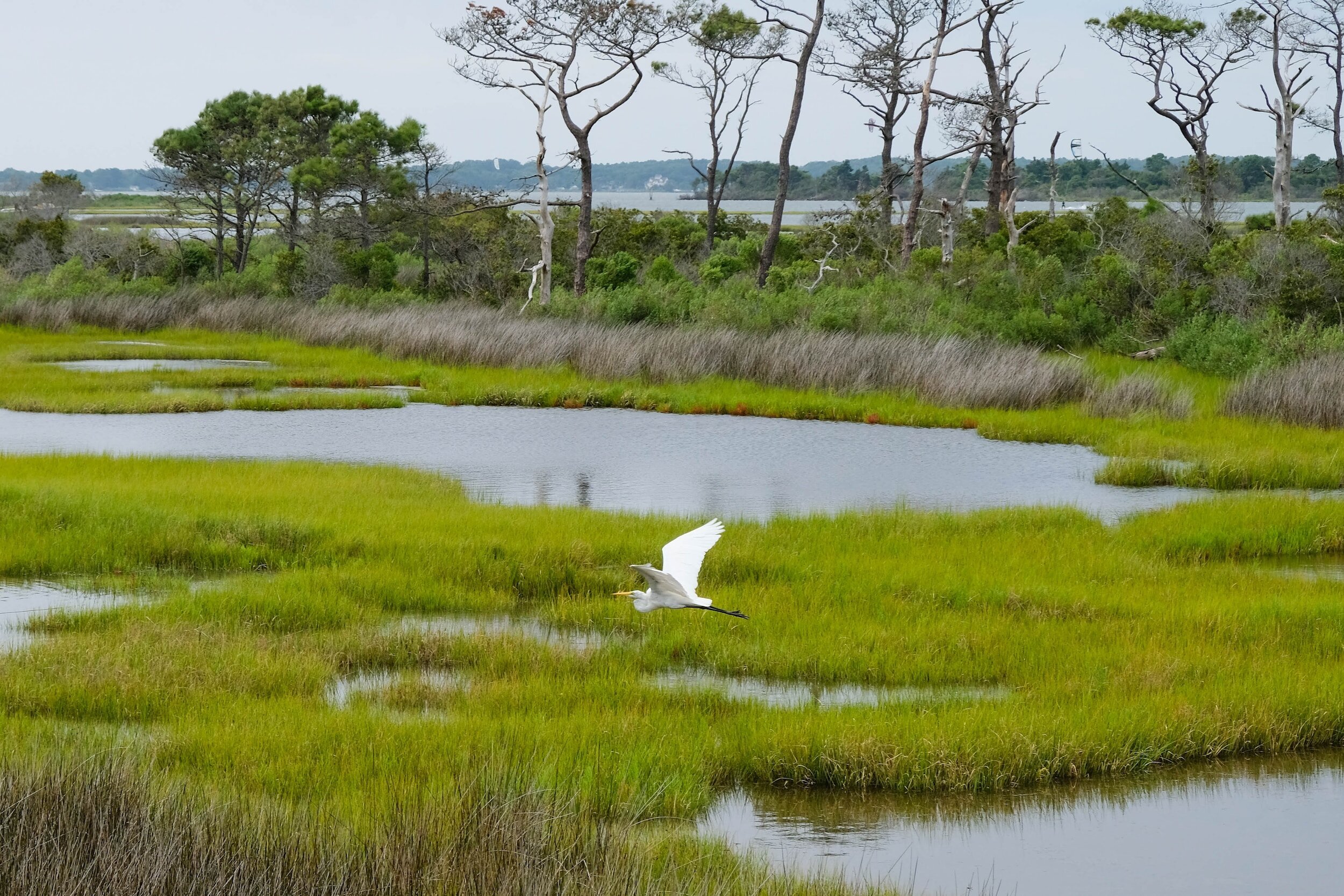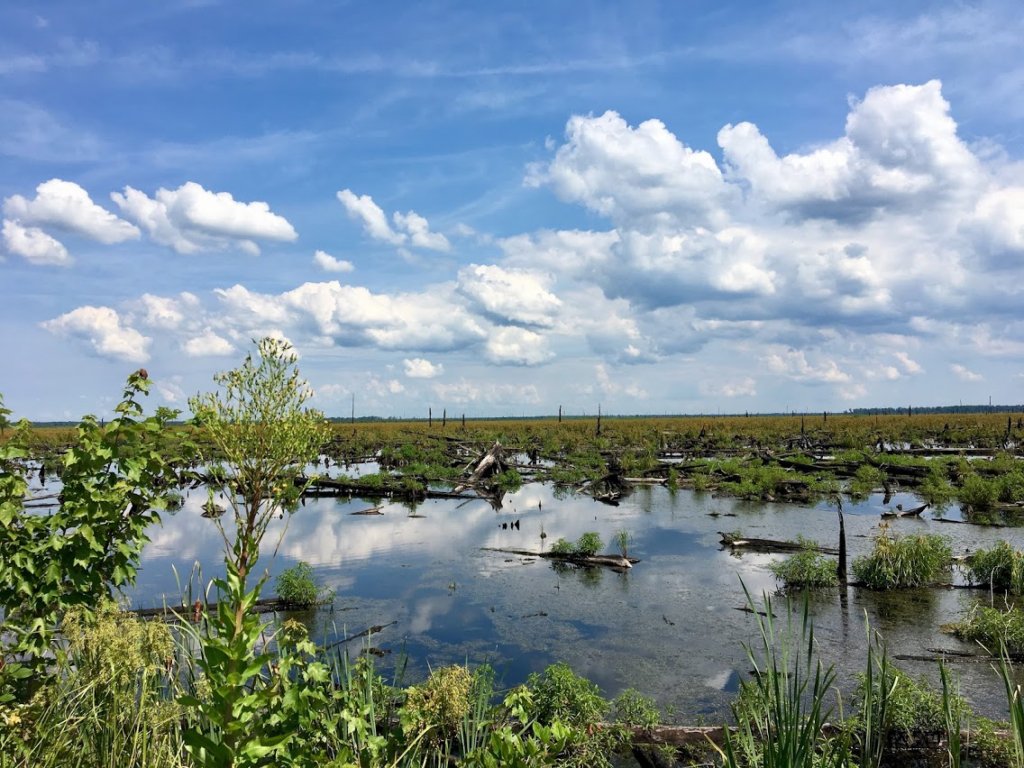
Wetlands & Public Policy Initiative
Why Wetlands?
You will generally find wetlands wherever the land meets water, a dynamic, ever-changing space. They constantly adapt to the ebb and flow of tides, storm surges, precipitation, and even droughts. This state of perpetual transition makes wetlands incredibly versatile, allowing them to perform multiple critical functions. Wetlands are natural purifiers, removing pollutants from water, protectors against storm surges and flooding, and are some of the most productive ecosystems on the planet, absorbing carbon and nurturing diverse forms of life.
It's easy to misinterpret wetlands as fragile or unstable given their dynamic nature, where the boundaries between land and water continually blur. The constant give and take of land and water doesn’t break ecosystems down; it builds them up. This interplay creates conditions for a wide range of species to thrive, with wetlands serving as vital habitats that support countless forms of life—from birds and amphibians to fish and invertebrates.
Critical Wildlife Habitat
Wetlands are indispensable to the survival of aquatic life, particularly for the finfish and shellfish species that sustain both ecosystems and economies. Approximately 90% of commercially harvested fish and shellfish spend a portion of their lifecycle in wetlands, relying on these habitats for foundational functions such as breeding, spawning, and as nurseries for their young. The dense vegetation and nutrient-rich waters of wetlands provide shelter and sustenance, offering young fish and shellfish protection from predators and a place to grow before moving into deeper waters. The loss or degradation of wetlands would not only disrupt these vital life cycles but also threaten the commercial fishing industries and coastal communities that depend on them. Protecting and restoring wetlands is essential not only for biodiversity but for sustaining the livelihoods of millions of people around the world.
The complex interplay of land and water within wetlands allows for the presence of both water and land species, many of which are specially adapted to thrive in these transitional spaces. Wetlands also serve as critical stopover points for migratory birds, providing them with essential resources during their long journeys.
The loss or degradation of wetlands poses a significant threat to the survival of many species, underscoring the importance of preserving these vital ecosystems for the continued health and stability of local and regional biodiversity.
Community Resilience: Clean Water, Reduced Impacts From Flooding, & Resistance to Erosion
Wetlands are crucial in enhancing our resilience to the increasing threats posed by climate change. Acting as natural sponges, they absorb wave energy and hold excess water during storms and gradually release it, mitigating the impacts of flooding and erosion. Wetlands also serve as nature’s water purifiers, filtering out pollutants and sediments before they reach rivers and streams - safeguarding water quality.
What makes wetlands truly unique is their dual ability to both mitigate climate change (as carbon sinks) and help us adapt to its effects—a function that is more essential now than ever. Beyond their role as wildlife habitats, wetlands are increasingly recognized as vital components of community resilience and environmental planning.
The Time to Act is Now
The challenge we face is urgent. As of 2024, Virginia has already lost approximately 42% of its original wetlands. If current trends persist, and no actions are taken, projections indicate that Virginia will lose up to 89% of its remaining tidal wetlands by 2100.
The projected loss of nine of every ten acres of wetlands highlights the need for immediate and comprehensive policy support, along with widespread conservation efforts, to protect and restore these essential ecosystems before we lose them forever.
This growing recognition has led to a reevaluation of wetlands as critical natural infrastructure. Their capacity to dampen wave energy, prevent erosion, and enhance water quality positions wetlands as some of the most cost-effective and sustainable solutions to the environmental challenges posed by climate change and urbanization.
As natural hydrological regulators, wetlands are unmatched in their ability to absorb water and wave energy during storm events, reducing the immediate impacts of flooding on surrounding communities. Following these events, wetlands gradually release stored water, sustaining stream flows during dry periods and replenishing groundwater reserves. This dynamic water retention and release mechanism is essential for maintaining the balance of local water cycles, particularly in regions prone to extreme weather events.
Wetlands play an indispensable role in water purification. As water moves through these ecosystems, it undergoes natural filtration, with wetland vegetation, soils, and microbial communities working together to remove pollutants such as excessive nutrients, heavy metals, and pathogens. This process not only improves the quality of water entering groundwater systems but also supports the health of downstream aquatic ecosystems. By reducing pollutant loads, wetlands contribute significantly to the overall integrity of watersheds, sustaining both ecological and human communities that rely on clean water resources.
Protecting and restoring wetlands is not just an investment in environmental health but a critical strategy for building resilient communities capable of withstanding the challenges of a changing climate.
Economic Benefits of Wetlands
Beyond their ecological significance, wetlands are economic powerhouses that deliver critical services to communities and local economies. These natural community assets play a vital role in storm protection, flood mitigation, and coastal resilience. In the U.S. alone, coastal wetlands provide an estimated $23.2 billion in storm protection services annually. Restoration efforts in areas like the Gulf of Mexico have shown benefit-to-cost ratios exceeding seven to one, proving that investing in wetlands yields substantial economic returns. In Virginia, Wetlands Watch helps local governments create annual flood insurance discounts through conservation of wetlands, through the Community Rating System program. From safeguarding properties during hurricanes, to lowering annual flood losses, wetlands offer cost-effective and sustainable solutions to the environmental challenges posed by climate change and urbanization. Protecting and restoring these invaluable ecosystems is not only a matter of ecological preservation, but also a sound economic strategy that supports the resilience and prosperity of communities.
Comprehensive Policy Engagement: State, Local, and Federal Outreach
Local Initiatives
Beyond our policy work, Wetlands Watch is renowned for its grassroots efforts. For over a decade, we have partnered with localities—rural and urban, coastal and riverine—to defend, restore, and adapt their wetland and shoreline resources. We provide in-depth guidance on best planning practices, offer professional training to support these efforts, and actively pursue funding opportunities for shoreline restoration projects.
We also rigorously review permit applications under Virginia’s Chesapeake Bay Preservation and Wetlands Acts, focusing particularly on those seeking to drain, alter, or develop tidal or non-tidal wetlands. We advocate against any actions deemed harmful or imprudent and collaborate weekly with numerous Virginia nonprofits and localities to ensure the preservation of these invaluable natural resources for future generations.
State & Regional Advocacy
Wetlands Watch is deeply committed to ensuring all policy aligns with the Commonwealth's goal of achieving a "no-net loss of existing wetlands acreage and function." Our organization has been instrumental in shaping key legislative frameworks, such as the Chesapeake Bay Preservation Act and the Tidal Wetlands Act, to ensure that climate change impacts are fully considered in the regulation of shoreline activities in Virginia. We have provided the Virginia Marine Resources Commission with critical regulatory guidance on the new provisions of the Tidal Wetlands Act and offered expert advice to the Department of Environmental Quality on the updated Chesapeake Bay Protection Act regulations.
Our engagement extends to active participation on the Virginia Coastal Resilience Master Plan Technical Advisory Committee under both Republican and Democratic administrations, where we offer expert strategies to adapt to climate change impacts across the state. Additionally, we recently completed our appointment as Vice Chair of the Virginia Land Conservation Foundation, a board that finances the protection of Virginia's land and natural resources.
Our advisory roles also include contributing to the committee responsible for updating Virginia’s septic regulations to account for climate change and ensuring the integration of climate change into tidal wetlands mitigation regulation.
Our influence is evident in statewide policy development, where we significantly contributed to Virginia’s Coastal Resilience Master Planning Framework in 2020 and the subsequent Coastal Resilience Master Plan in 2021. Ensuring that Virginia’s wetlands can withstand the accelerating impacts of sea level rise is central to all our strategic efforts.
Federal Engagement
On the federal level, Wetlands Watch plays a technical expert role in providing Congressional testimony and briefings on key environmental issues. In 2023, we testified before the House Subcommittee on Water, Wildlife, and Fisheries in strong support of HR. 4590, a bill that expands the Coastal Barrier Resources System (CBRS). Our testimony also emphasized the need for a Coastal Hazards Pilot Project within the bill, ensuring CBRS lands can adapt to rising sea levels, mirroring similar initiatives in Virginia aimed at protecting wetland migration corridors.
In 2024, Mary-Carson Stiff, Executive Director of Wetlands Watch, delivered a critical briefing to Congressional staff on the national security risks associated with climate change in Virginia. Mary-Carson focused on the Department of Defense's pivotal role in state and local climate planning, particularly in the Hampton Roads region, where rapid sea level rise threatens military readiness and infrastructure. Her presentation called for enhanced support for local governments leading climate adaptation efforts, emphasizing the urgency of addressing these challenges.
Programs
Wetlands Migration Planning
Recognizing the important role of wetlands in flood protection, water purification, and biodiversity, Wetlands Watch conducts comprehensive wetlands migration planning to facilitate inland movement as sea levels rise, preventing wetlands from drowning in place. This involves assessing vulnerable areas, identifying migration pathways, and developing supportive policies and legal tools. Through partnerships with local governments, landowners, land trusts, and developers, Wetlands Watch promotes innovative strategies such as rolling easements and adaptive living shorelines to ensure wetlands can continue to provide essential ecosystem services as they migrate.
A notable Wetlands Watch collaboration with NASA DEVELOP led to a predictive model that shows how much of the projected wetlands loss in Hampton Roads and Virginia’s Eastern Shore can be mitigated through urban land conversion into wetland habitats.
We are also exploring ways to help wetlands “persist in place,” which essentially means adding sediment to wetlands over time, to help keep pace with sea level rise. This work is in an exploratory phase, but we know this approach will be one tool in the toolbox to protect wetlands over time.
Wetlands Permit Review Program
We monitor permit applications on lands regulated by Virginia’s Wetlands Acts and the Chesapeake Bay Preservation Act, research those that seem problematic, and fight against proposed actions that we believe are contrary to Virginia regulations and the state’s commitment to no-net loss of wetlands.
Wetlands of interest for 2024 include the Suffolk Dismal Swamp Wetlands, the Nimmo Quay and Back Bay Wildlife Refuge wetlands in Virginia Beach, and Fort Monroe wetlands in Hampton. We are also interested in what we’re calling “transitional tidal wetlands,” those that are transitioning from freshwater to tidal due to increasingly frequent high tides.
Projects
RGGI Defense
The Regional Greenhouse Gas Initiative (RGGI) is a cooperative cap-and-trade program designed to reduce carbon emissions from the power sector. Virginia’s participation in RGGI is mandated by the Clean Energy and Community Flood Preparedness Act of 2020, which also directs the proceeds from the sale of carbon allowances into the Community Flood Preparedness Fund (CFPF).
The Community Flood Preparedness Fund supports flood resilience projects across the Commonwealth and has distributed approximately $151 million since its inception.
By withdrawing Virginia from RGGI, Governor Youngkin has effectively removed hundreds of millions of dollars in pre-disaster resilience funding from the Commonwealth’s most vulnerable communities. We believe this action is not only harmful but also illegal.
We believe that when Youngkin used administrative power it violated the legislative mandate established by the General Assembly. This approach also undermines the balance of power between the executive and legislative branches as outlined in the Virginia Constitution.
Sackett Defense
The Sackett v. EPA decision (2023) by the United States Supreme Court significantly narrows the definition of the Waters of the United States (WOTUS), weakening federal wetlands protections across the nation. In Virginia, where state laws offer more stringent protections for both tidal and non-tidal wetlands, the implications of the Sackett decision pose a serious threat to the Commonwealth’s conservation legacy.
Adopting the "Sackett Rule" in Virginia could result in the loss of protections for over 35% of Virginia's wetlands, undermining decades of bipartisan efforts to safeguard these critical ecosystems. Such a rollback would not only jeopardize the environmental integrity of Virginia’s wetlands—known for their biodiversity and role in flood damage mitigation—but also have significant economic and social repercussions.
Aligning state laws with the new federal standard (“federal consistency”) would disregard the complex hydrological connections that define wetlands. Post-Sackett, wetlands are now only protected by federal law if they have a “surface water connection.” We know wetlands are often connected under the surface. We must of resist calls for "federal consistency" to protect common sense science in Virginia and sustain the state’s ecological health and climate resilience.
Developed by Wetlands Watch, the Commonwealth Resilience Brief a streamlined technical tool designed specifically for professionals in the resilience field. Each issue cuts through the clutter to deliver concise updates on
Policy & Regulatory Changes. Get the latest on legislative actions and regulatory shifts that are shaping the resilience landscape.
Financial Resources. Stay informed about emerging funding opportunities and budget amendments vital for advancing resilience initiatives.
Innovations & Collaboration. Discover new technologies and strategies, and read expert commentary that drives community-wide knowledge sharing.
If you missed any key developments, the Brief has you covered with distilled, actionable insights to keep you ahead in Virginia’s rapidly evolving resilience space.










